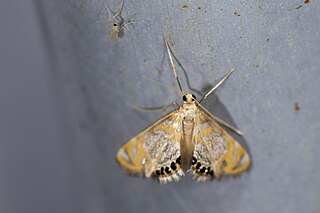Related Research Articles

Crambidae comprises the grass moth family of lepidopterans. They are variable in appearance, with the nominal subfamily Crambinae taking up closely folded postures on grass stems where they are inconspicuous, while other subfamilies include brightly coloured and patterned insects that rest in wing-spread attitudes.

The Pyralidae, commonly called pyralid moths, snout moths or grass moths, are a family of Lepidoptera in the ditrysian superfamily Pyraloidea. In many classifications, the grass moths (Crambidae) are included in the Pyralidae as a subfamily, making the combined group one of the largest families in the Lepidoptera. The latest review by Eugene G. Munroe and Maria Alma Solis retain the Crambidae as a full family of Pyraloidea.

Eudonia lacustrata is a species of moth of the family Crambidae described by Georg Wolfgang Franz Panzer in 1804. It is found in Europe, north-west Africa, Asia from Turkey, Iran and Syria to Siberia and the western part of China (Hunan). The subspecies E. lacustrata persica is found in Iran and Armenia.

Eoophyla is a genus of moths of the family Crambidae. It was erected by Charles Swinhoe in 1900.

Eristena is a genus of moths of the family Crambidae.
Margarosticha is a genus of moths of the family Crambidae.

Nymphicula is a genus of moths of the family Crambidae.

Paracymoriza is a genus of moths of the family Crambidae.

Parapoynx is a genus of moths of the family Crambidae described by Jacob Hübner in 1825.
Musotiminae is a subfamily of the lepidopteran family Crambidae. It was described by Edward Meyrick in 1884
References
- Pitkin, Brian & Jenkins, Paul. "Search results Family: Crambidae, Genus: starts with W". Butterflies and Moths of the World. Natural History Museum, London.